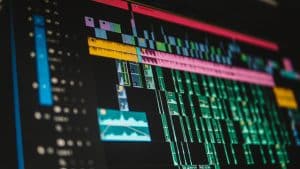From overlays to motion graphics — here are some of the key video editing effects you need to know.
Whether you’re a wedding videographer, a corporate editor, or a documentarian, there are several effects you absolutely need to know before taking on your next gig. These types of effects can manipulate, distort, enhance, and improve your footage in very specific ways that can take your images from good to great.
Let’s break down a few of the major effects that will help you the most.
Pans and Tilts
When you hear these two words, your first thought might be tripod movements. However, in this article, we’re going to talk about panning and tilting within your editing program. This is a fast solution to making your video more dynamic with extra movement and feeling.
First, you’ll need to zoom in on your shot — this will give you space to move up or down without running out of pixels. Once you’ve zoomed in, all you have to do is set a key frame at the beginning of the clip and drag the clip either to left/right or up/down and set your next key frame at the end of clip; then, move the position of the clip back to where you started. Now the clip will pan or tilt as your playhead moves through the clip and onto the next shot.
You can also simulate an in-camera zoom this same way. All you need to do is set a key frame (again at the beginning of the clip), move to the end of the clip, zoom in a little bit, then set your second key frame. Voilà!
This is great when you get a request from your clients along the lines of “There needs to be more movement in the edit.” This little post-production trick is a great way to satisfy that request.
Change the Speed/Duration
One feature that almost every NLE offers is the ability to alter the playback speed of your video while also shortening or lengthening the actual duration and speed of your clips. One of the biggest reasons you would do this is to slow your footage down to match the frame rate at which you recorded the video.
You can use this create slow-motion shots and fast-forward effects to fit certain fast-paced or chaotic moments into your project. This is also a useful effect for speeding through footage for comedic effect. To do this, find the “Speed/Duration” option in your Effects controls (or by right-clicking on your clip and selecting the option to change it).
Light Leaks and Flares
Nothing gives your footage a dreamier feel than soft warm light blooming from somewhere on the image. This light can come either from a direct source that’s visible in the shot, or it can creep in from the edge of the frame. These types of flares and leaks are a staple of filmmaking that you’ve most likely seen countless times in films, whether caused by the lens the cinematographer used, or added in post (which is what we’ll be talking about).
So, to pull this one off, find a free effect like this one, drag it onto your timeline, and change the blend mode while you position it accordingly on your image. You can choose to have the light coming from wherever you want, as long as its not distracting. Remember, it’s important that these leaks and flares enhance the story, remaining just visible to the viewer’s eye. Below is a list of some free video effects you can download to play around with in your edit!
Retro/VHS Effects
While lens flares and light leaks create a timeless feel, there’s nothing that makes your video or film feel dated — or, one might say, “scrappy”. The VHS look is one of the most popular effects right now because clients and filmmakers want that ’90s-era grunge look.
There are a few different ways to pull off this effect. First, you can apply a preset to your color grade; this will basically be a LUT (look-up-table — basically a filter) that tweaks the image to look a little blurrier, a little more desaturated, and a little fuzzier (using the different alpha and gamma channels). This will give your images an outline of distorted blues and reds that come from “chroma errors” produced from bad recordings and a lack of a flying erase head (a feature that allows you to record over footage you’ve already shot. (Think of it like formatting your SD card, but the footage is still on the card, and you’re just recording over it).
Here’s how you can do this trick in Premiere, DaVinci Resolve, and Final Cut:
At some point in your video editing career, you’re almost guaranteed to come across a job or request from a client that asks for this retro aesthetic — now you’ll know what to do!
Color Grading and Color Correction
Perhaps the most important step in the post-production process (aside from the actual editing) is color correction and color grading. These tools will allow you to change the color temperature and skin tones, adjust the highlights and shadows, add vignettes, play with the contrast and much much more. While this topic deserves its own ebook, we’re going to briefly discuss one element of color grading: the ability to change specific colors within your image.
This is perhaps the most common request I receive from clients: to change one color of one object within your shot — usually to match their branding needs. Every editing program out there offers a solution to this problem!
Adding Overlays
We’ve discussed applying overlays — whether it’s VHS effects, or a light leak — however, there are many different types of overlays for editing you can use that add specific elements to your shot, like weather particles!
These types of video overlays add depth and production value to your footage that you might have missed on the day of the shoot — or maybe you just weren’t able to get these elements in your shot. For example, sometimes you might be shooting in the snow, but without any accumulated snowfall. You can take a clip of snowfall like this, and comp it into your scene so that your footage looks like you shot it during a snowstorm.
These types of editing tricks are fairly simple. Be ready to learn a lot about blend modes, masks, keying and using multiple layers on your timeline — or in your comp. If you’re not using After Effects, you can still pull this type of effect off in programs like Premiere, Final Cut Pro X, and DaVinci Resolve. Check out the tutorials below! Using video overlays comfortably takes some practice, but just keep playing around with these tools in your NLE, and you’ll find the process that works for you.
Using Titles and Motion Graphics
Every professional-looking video needs clean titles and/or motion graphics. These might be main titles, lower thirds, post-credits, animated logo reveals, or even subtitles. No matter the program you’re editing in, there are lists of free fonts you can use that will make your project stand out.
Once you have the right font, color and weight picked out, it’s time to move on to motion graphics. These are important because they can take a simple, timeless title or text and turn it into a moving, fun representation of the brand or idea your video is trying to promote.
Learning the basics of motion graphics is a piece of cake now that there are thousands and thousands of tutorials at our disposal. Like I said before, no matter the editing program you use, all of the different effects and movement you’d want to learn are right at your fingertips. Below is a brief list of basic tutorials I’ve found to be extremely helpful in my own motion graphics journey.
- 4 Editing Motion Graphic Techniques
- 4 DaVinci Resolve Motion Graphics for Beginners
- How to Animate Objects in Final Cut Pro
Like any aspect of filmmaking, these different techniques and tricks take time to master. There will most definitely be a lot of trial-and-error as you incorporate these video editing effects into your editing repertoire, but they will eventually become second nature to your process.
Good luck out there, editor!
Cover image via Videvo.
Looking for video assets for your projects? We’ve got you covered.




